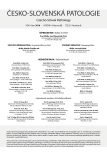-
Medical journals
- Career
Injury of upper cervical spine
Authors: Luděk Ryba; Jan Cienciala; Richard Chaloupka; Martin Repko; Robert Vyskočil
Authors‘ workplace: Ortopedická klinika LF MU a FN Brno
Published in: Soud Lék., 61, 2016, No. 2, p. 20-25
Category: Review
Overview
Injuries of the upper cervical spine represent 1/3 of all cervical spine injuries and approximately 40 % result by the death. Every level of the cervical spine can be injured – fractures of condyles of the occipital bone (CO), atlantooccipital dislocation (AOD), fractures of the Atlas (C1), atlantoaxial dislocation (AAD) and fractures of the axis (C2). Most of cases in younger patients are caused by high-energy trauma, while by elderly people, because of the osteoporosis, is needed much less energy and even simple falls can cause the injury of the cervical spine. That´s why the etiology of injuries can be different. In younger patients are caused mainly by car accidents, motorcycle and bicycle accidents and pedestrian crashes by car and in elderly populations are the main reason falls. The mechanism of the injury is axial force, hyperflexion, hyperextension, latero-flexion, rotation and combination of all. The basic diagnostic examination is X ray in AP, lateral and transoral projection. But in the most of cases is CT examination necessary and in the suspicion of the ligamentous injury and neurological deterioration must be MRI examination added. Every injury of the upper cervical spine has its own classification. Clinical symptoms can vary from the neck pain, restricted range of motion, antalgic position of the head, injury of the cranial nerves and different neurologic symptoms from the irritation of nerves to quadriplegia. A large percentage of deaths is at the time of the injury. Therapy is divided to conservative treatment, which is indicated in bone injuries with minimal dislocation. In more severe cases, with the dislocation and ligamentous injury, when is high chance of the instability, is indicated the surgical treatment. We can use anterior or posterior approach, make the osteosynthesis, stabilisation and fusion of the spine. Complex fractures and combination of different types of injuries are often present in this part of the spine. Correct and early diagnosis with the best treatment option is necessary for successful result of the cervical spine injuries.
Keywords:
injury – traumatology – cervical spine – blunt injury – biomechanics of trauma – heaviness of injury
Sources
1. Greene KA, Dickman CA, Marciano FF, Drabier JB, Hadley MN, Sonntag VK. Acute axis fractures. Analysis of management and outcome in 340 consecutive cases. Spine 1997; 22 : 1843-1852.
2. Adámek T. Hladík J. Štefan J. Vyhnánek F. Epidemiologická studie smrtelných úrazu pitvaných v Ústavu soudního lékařství 3. LF UK a FNKV v Praze v letech 1996-1999. Soud lek 2001; 46(2): 21-23.
3. Alcelik I, Manik KS, Sian PS, Khoshneviszadeh SE. Occipital condylar frastures. Review of the literature and case report. J Bone Jt Surgery 2006; 88 B: 665-669.
4. Bell C. Surgical pbservations. Middlesex Hosp J 1817; 4 : 469.
5. Anderson PA, Montesano PX. Morphology and treatment of occipital condyle fractures. Spine 1988; 13 : 731-736.
6. Jeanneret B. Obere Halswirbesaule. In: Hohman G, Hackenbroch M, Lindemann K. Orthopädie in Praxis und Klinik, 2. Auflage, Stuttgart-New York: Thieme 1994.
7. Blackwood NJ. Atlanto-occipital dislocation. Ann Surg 1908; 47 : 654-658.
8. Traynelis VC, Marano GD, Dunker RO, et al. Traumatic Atlanto-occipital dislocation: Case report. J Neurosurg 1986; 65 : 863-870.
9. Jeanneret B. Obere Halswirbesaule. In: Hohman G, Hackenbroch M, Lindemann K. Orthopädie in Praxis und Klinik, 2. Auflage, Stuttgart-New York: Thieme 1994.
10. Kočiš J, Wendsche P, Mužík V. Traumatická atlantookcipitální dislokace. Acta Chir Orthop Traum Cech 2004; 71/2 : 336-372.
11. Štulík J, et al. Poranění krční páteře. Galen; 2010 : 100-110.
12. Jefferson G. Fracture of the atlas vertebra. Report of four cases, and a review of those previously recorded. Brit J Surg 1920; 407-422.
13. Gehweiler JA, Osborne RL, Becker RF. The radiology of vertebral trauma. Philadelphia; Saunders 1980.
14. Dickman CA, Greene KA, Sonntag VK. Injuries involving the transverse atlantal ligament: classification and treatment guidelines based upon experience with 39 injuries. Neurosurgery 1996; 38 : 44-50.
15. Spoor AB, Diekerhof CH, Bonnet M, Öner FC. Traumatic complex dislocation of the atlanto-axial joint with odontoid and C2 superior articular facet fracture. Spine 2008; 33 : 708-711.
16. Fieleding JW, Hawkins RJ. Atlanto-axial rotatory fixation. J Bone Jt Surg 1977; 59A: 37-44.
17. Štulík j, Krbec M. Atlantoaxiální rotační dislokace ( kazuistika). Acta Chir Orthop Traum Cech 2002; 69(1): 49-53.
18. Anderson LD, D´Alonzo RT. Fractures of the odontoid process of the axis. J Bone Jt Surg 1974; 56A: 1663-1674.
19. Štulík J, Suchomel P, Lukáš R, et al. Přímá osteosyntéza dentu - multicentrická studie. Acta Chir Orthop Traum Cech 2002; 69(3): 141-148.
20. Houghton S. On hanging, considered from a mechanical and physiological point of view. Philos Mag J Sci 1866; 32 : 23-34.
21. Marshall JJD. Judical executions. BMJ 1888; 779-782.
22. Efendi B, Roy D, Cornish B, Dussault RG, Lauring CA. Fractures of the ring of the axis: A classification based on the analysis of 131 cases. J Bone Jt Surg 1981; 63B: 319-327.
23. Judet R, Roy-Camille R, Sailant G. Actualités de chirurgie orthopédique de l´Hopital Raymond-Poincare. VIII. Fractures du rachis cervical. Paris: Masson 1970.
24. Štulík J, Vyskočil T, Šebesta P, Kryl J. Komplexní atlantoaxiální zlomeniny. Acta Chir Orthop Traum Cech 2005; 72(2): 105-110.
Labels
Anatomical pathology Forensic medical examiner Toxicology
Article was published inForensic Medicine

2016 Issue 2
Most read in this issue- Injury of upper cervical spine
- Benefits of otoscopy in forensic autopsy practice: A prospective study
- Right haemothorax related to the rupture of abdominal aortic aneurysm
Login#ADS_BOTTOM_SCRIPTS#Forgotten passwordEnter the email address that you registered with. We will send you instructions on how to set a new password.
- Career

